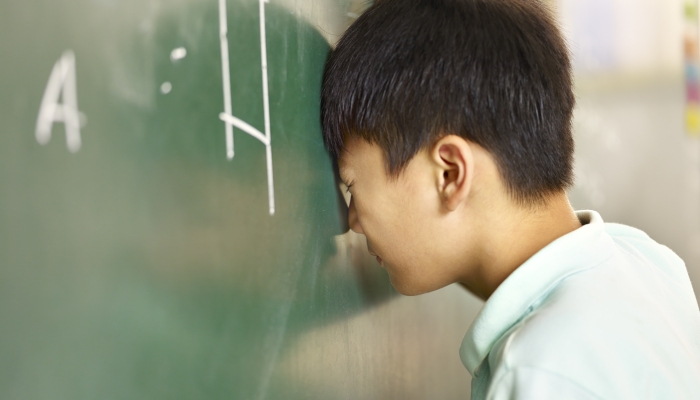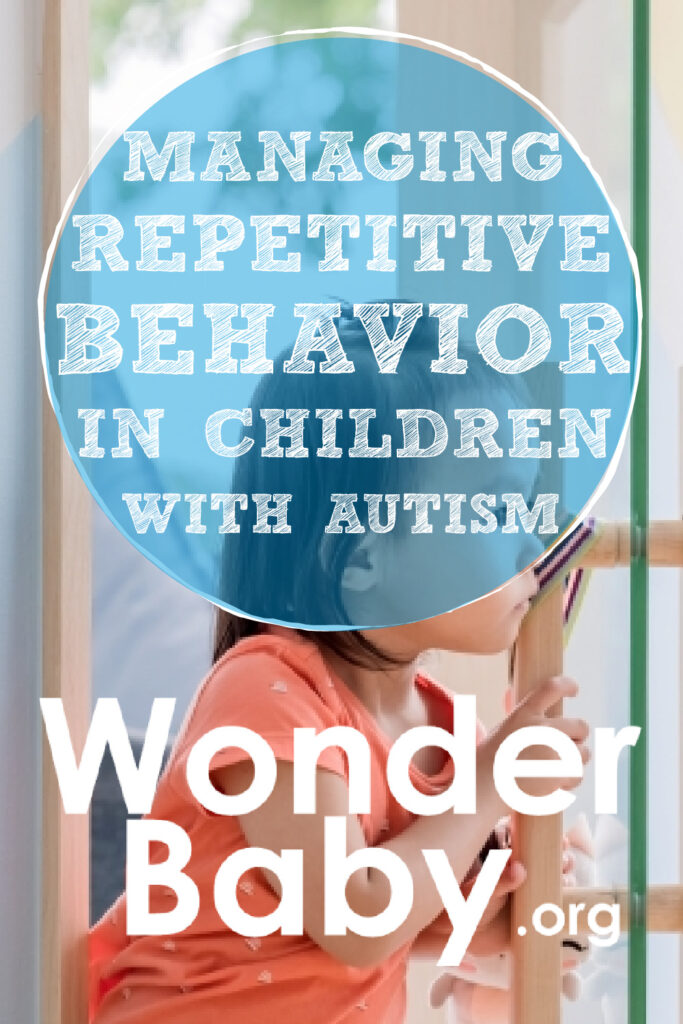Managing Repetitive Behavior in Children With Autism

- People with autism may be triggered to repeat behaviors by stress or overstimulation.
- Repetitive behaviors can be soothing for people with autism.
- Repetitive behaviors are a problem when they cause harm or impair daily living.
- You can help your child manage repetitive behaviors by removing the trigger or helping them substitute the behavior.
Research suggests that repetitive and restricted behaviors are common signs of autism. People with autism may engage in repetitive behaviors to block out stimulation from the outside world.
Some repetitive behavior symptoms may not cause problems for your child, but parents need to identify when these behaviors are harmful and when they are helpful.
Managing repetitive behavior in children with autism is possible, and it’s an essential step in avoiding self-harm and improving social skills.
Identifying Repetitive Behaviors in Children
Infants and toddlers love patterns. Many small toddlers love to read the same story over and over, or they may want to sing the same song before bed every night or tell the same joke a hundred times.
This love for patterns is not the same as compulsive, repetitive behaviors. Repetitive motor movements with an inability to focus on other activities may be a sign of a developmental disability, as are restricted interests and an inability to change routine.
Normal repetitive behaviors
Some repetitive behaviors are part of typical development for a child. A toddler may push the same button on an object over and over. School-age kids may fidget or tap a pencil when they are bored.
Such behavior is normal for kids if it is infrequent and easily redirected.
Abnormal repetitive behaviors
The National Autistic Society states that repetitive and restrictive behaviors are concerning when they become a ritualistic behavior in which stopping a person during these repetitive movements can cause anxiety.
Some examples of repetitive behaviors in autism include:
- Spinning objects
- Body rocking
- Hand flapping
- Self Harm – head banging or hitting
- Repeatedly opening and closing doors
- Insistence on sameness
- Echolalia
- Asking the same question repeatedly
- Telling the same story over and over

Are Repetitive Behaviors an Indication of Autism?
When a child engages in repetitive and restricted behaviors, they should be assessed for developmental disorders like autism spectrum disorders.
Repetitive motor behaviors do not guarantee an autism diagnosis. However, they are one of the most common signs.
Developmental disorders where repetitive behaviors can be observed
Repetitive behaviors can be seen in many different disorders. People with Autism, OCD, or ADHD are likely to exhibit repetitive behaviors.
Some behaviors may be mild, like bouncing a foot, while others may be severe and can consume an entire day or cause harm. Behavioral interventions are needed to prevent injury from this type of behavior.
Autism Spectrum Disorder
Many developmental disabilities can cause variations in behavior and sensory problems. Autism is the most common cause of repetitive behaviors.
Diagnostic criteria for autism include;
- Severely abnormal social interactions
- Deficits in nonverbal communication
- Difficulty interacting with peers
The severity of autism is based on communication and repetitive behavior patterns. For example:
- Intense interest in unusual objects
- Inflexible routines like always taking the same route or wanting to eat the same food every day
- Hyper or hypo-reactivity to sensory input such as a fascination with certain sounds or visual stimuli or an aversion to specific textures
- Repetitive rhythmic behaviors like hand flapping, body rocking, or head banging
An important aspect of autism is that it is not a sign of mental retardation. Many autistic people have an IQ at or above average. More research shows that autism is a neurodivergent disorder, not an intellectual disability.
Obsessive Compulsive Disorder
Although they are different conditions, OCD and autism frequently occur together. 17% of people with autism also have OCD. OCD behaviors can fit into the broad category of repetitive behavior.
Generally, the insistence of sameness or repetition for an autistic child is purposeless. For a child with OCD, the behavior is driven by anxiety.
Diagnostic criteria for OCD include:
- Presence of obsessions, compulsions, or both
- The obsessions or compulsions take up at least one hour per day
- The behavior causes social or occupational problems
Attention Deficit Hyperactivity Disorder
People with ADHD often engage in body-focused repetitive behaviors. These include nail biting, hair pulling, and picking at skin, and are often triggered by boredom or an inability to pay attention.
Criteria that must be met for an ADHD diagnosis include:
- Fails to pay attention to details
- Does not seem to listen when spoken to directly
- Has difficulty organizing tasks
- Is easily distracted by external stimuli
- Is often forgetful in daily activities
What Can Trigger Repetitive Behaviors in Children With Autism?
There is some debate about what triggers repetitive behaviors in a person with autism.
Some researchers suggest that these movements serve no purpose. Others claim that these behaviors and intense interests reduce stress and block out the outside world.
Some adults with autism have described their hand flapping and rocking as a way to express excitement or relieve anxiety.
When Do Repetitive Behaviors Become a Problem?
Some repetitive behaviors in autism are harmless. A person who rocks back and forth may seem strange to others, but such behavior rarely needs a behavioral intervention.
Anything that causes harm to self or others should be stopped right away. If a person engages in head banging or biting, you should do everything you can to help them calm down.
Other activities that cause problems are ones that interfere with a person getting their needs met. For example, a child who is not getting their nutritional needs met due to a routine that only allows eating one food will need to learn to accept a variety of foods into their diet.
People with autism may also place a greater emphasis on their intense interests than on paying attention in school. Their obsession with objects or subjects in one area may cause them to lose focus in all other areas. A child who is obsessed with a tank engine or train schedules does not have time to focus on social studies, for example.

Managing Repetitive Behaviors in Children With Autism
Many parents want to manage their child’s unwanted behavior. Researchers have found some effective strategies for managing harmful behaviors in children. For repetitive or restricted behaviors that do not cause injury, the best strategy may be to accept the behavior.
Applied Behavior Analysis
Applied Behavior Analysis (ABA) is the most commonly used therapy for people with autism, although more recenlty this treatment has become controversial.
Many parents report that applied behavior analysis is effective for their children. Some with non verbal toddlers now have children who can write their name and communicate after therapy.
However, activist groups against this type of therapy believe that the approach is too harsh and is harmful for autistic children.
The goal of Applied Behavior Analysis is to help people with autism learn to function normally in society. While this type of therapy often helps children fit in, it also takes away part of their identity.
Other therapies
Speech, occupational, and physical therapies are an important part of a child’s individualized treatment plan.
The goal of occupational therapy is to help your child participate in their own self-care. Occupational therapists help your child learn to do things like bathe and brush their own teeth. Occupational therapy is one of the most effective tools for helping your child function at their best.
Physical therapy is an option for children who need help with motor skills or have low muscle tone.
Speech therapy helps your child communicate their needs and understand social interactions. Speech therapists can also help your child develop oral-motor skills if they struggle to chew or swallow food.
Autism research suggests that the best way to stop repetitive behavior is to find the trigger and remove it.
For example, if you notice your child starts banging his head when a loud truck drives by, move him to a quiet place or keep him somewhere the noise can’t bother him. You may also want to look into purchasing noise-canceling headphones.
You can try distraction techniques for your child, or you can try replacing the harmful behavior with something more acceptable. Perhaps a child who hits themselves can use a sensory toy instead.
Do Repetitive Behaviors in Autistic Children Ever Disappear?
Repetitive and restrictive behaviors decrease in about 75 percent of autistic children between the ages of 3 to 11.
Researchers found that the biggest decrease in symptoms happened between 3 and 6 years old. This decrease happened naturally.
Parents who placed greater emphasis on reducing the behaviors through therapy and mitigation techniques saw a slightly faster improvement. No children had their symptoms completely disappear.
FAQs
At what age is autism usually diagnosed?
A diagnosis of autism is difficult in very young children. Some young babies can be suspected of having autism spectrum disorder. A reliable diagnosis can be completed around age 2.
Some people with mild autism will not be diagnosed until later in childhood or even into adulthood. An early diagnosis can ensure that your child gets the help they need right away
Will my autistic child be able to function normally as an adult?
There are many high-functioning autistic children who become functioning adults. High-functioning autism, however, is a very broad category. It usually includes anyone who is able to live independently with limited assistance. According to autismspeaks.org, 44% of people with autism have IQ scores in the average to above average range.
What causes autism?
Research shows that genetics are involved in the majority of autism cases. Children with older parents are at higher risk for autism. If parents have one child with autism, their chances of a second child having autism are about 2-18%.
Extensive research has been conducted regarding a link between vaccinations and autism, and the conclusion over many studies is that vaccines do not cause autism.

The information WonderBaby provides is not intended to be, and does not constitute, medical or other health advice or diagnosis and should not be used as such. Always consult with a qualified medical professional about your specific circumstances.
Related Posts

Autism
Developing Time Management Skills in Children with Autism: 7 Tips
Learn how you can use structure and visual aids to help your child with autism learn time management skills.

Autism
Occupational Therapy for Children with Autism: How It Can Make a Difference
Children with autism face challenges in many different areas. Occupational therapy can help children address these difficulties while having fun!

Autism, Behavior
OCD vs Autism in Children: How To Tell the Difference
OCD and ASD are fundamentally different, but their symptoms are very similar. Learn how to tell the difference to support your child.